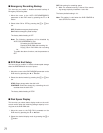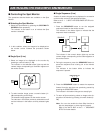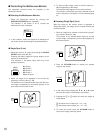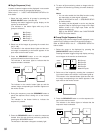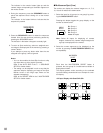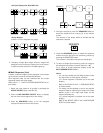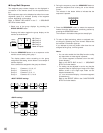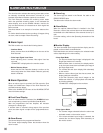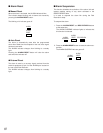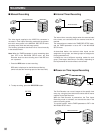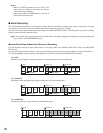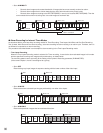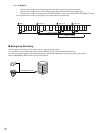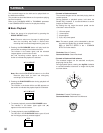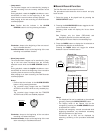
86
The alarm function activates the warning alarm status, when
an externally connected alarm sensor is turned on, or an
installed Video Motion Detector (optional) is activated.
The Disk Recorder activates the recording alarm status
within the specified recording mode; it also activates the
status display, such as the ALARM indicator, monitor dis-
play and alarm buzzer, to indicate that an alarm signal has
been received.
Described below is an example of an alarm status activa-
tion.
For further details related to the recording of images during
an alarm, refer to chapter "Alarm Recording".
■ Alarm Input
The Disk recorder can handle the following alarms.
• Interface Alarm
Alarm received from the ALARM port on the rear of the
Disk Recorder.
• Video Input Signal Loss Alarm
Alarm indicating that a camera video signal loss has
occurred.
“CH✽✽LOSS” is displayed on the monitor screen.
• Motion Detector Alarm
Alarm that the Disk Recorder detects a motion on the
video image when the Video Motion Detector (optional)
board is installed.
■ Alarm Operation
When an alarm signal is received, the Disk recorder, Spot
Output and Multiscreen Output of the Disk Recorder are
activated as shown below.
Refer to the ALARM SETUP menu of the WJ-HD500 SETUP
menu for further settings.
● Front Panel Display
When an alarm function is activated, the ALARM indicator
and corresponding camera input button (1 to 16) blink.
After the programmed time has elapsed, the indicator
changes to a steady light.
If another alarm is received during output of the previous
alarm, the alarm signal is output for the programmed dura-
tion.
● Alarm Buzzer
The buzzer beeps for the programmed duration.
The buzzer stops beeping before that duration when the
alarm is reset.
● Alarm Log
The alarm logs are stored in the Record List table or the
ERROR REPORT table.
The tables also indicate the alarm mode.
● Alarm Notice
When the optional Network Board is installed in the Disk
Recorder, notice of the received alarm can be automatically
transmitted to the Mail Address of the external device by e-
mail.
For further setting, refer to the Operating Instructions of the
board.
● Monitor Display
The alarm-activated input image and alarm display are dis-
played on the monitors as shown below.
Described below are several examples; the selected mode
varies, depending on the menu setting.
• Alarm Spot Mode
• The alarm-activated input image is displayed in the
Single Spot mode on the monitor.
When another alarm is received, the display switch-
es to the most recent alarm-activated input image in
the Single Spot mode.
• The camera title and alarm display blink alternately
on the monitor.
• When a camera video signal loss has occurred, the
display switches to blackout.
If the Disk Recorder plays back images on the
Multiscreen Monitor, it quits playback and switches
to a blackout display.
“CH✽✽LOSS” is displayed on the monitors.
• Alarm Ignore Mode
• The camera images selected before the alarm was
activated remain on the monitor screen.
• If the alarm-activated input image is selected, the
camera title and alarm display blink alternately on
the monitor screen.
CAM1 ALARM
CAM1 CH 1LOSS
ALARM CONTROL FUNCTION



